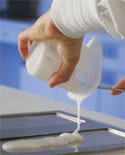Advancements in active drug-delivery technologies hold promise for precisely controlled, targeted treatments
April 1, 2008
Originally Published MPMN April 2008
SPECIAL FEATURE: DRUG DELIVERY
Silicones Show It's Okay to Be Passive
Return to Article: |
Despite the slew of developments in active drug delivery, passive technologies remain effective for many treatments. But in order for any drug-delivery method to be successful, selecting the right material for the application and then the right approach is paramount.
Silicones, in particular, lend themselves to use as excipients in passive drug-delivery applications ranging from transdermal to implanted technologies. They enable drug delivery through their incorporation into either a matrix system or reservoir design. In the case of a matrix, the drug is mixed directly into the silicone elastomer material and is then cured; the therapy then elutes out of the system over time, according to Stephen Bruner, marketing director of NuSil Technology (Carpinteria, CA; www.nusil.com), a supplier of silicone-based materials.
|
Silicone is commonly used as an excipient in passive drug delivery. |
“Sometimes, the chemistry of the drug interferes so much with the curing chemistry of the elastomer system, you may have to go to a reservoir system,” he explains. “The drug is concentrated in a cavity within the device and then sealed to prevent leaking. These systems take advantage of the release-rate properties of the silicone [because] the drug migrates from the cavity through the silicone.”
Frequently employed in patch technologies for nicotine addiction, birth control, and hormone replacement therapy, silicone is used for drug delivery because of its permeability to a range of small-molecule hydrophobic drugs. However, permeability of active agents is contingent on solubility and diffusivity.
“Drug-delivery companies must consider compatibility between the drug and the silicone to address the issue of solubility,” Bruner says. “A drug won’t deliver through a silicone unless it is chemically compatible; insoluble active ingredients or those that react with silicones are unable to move effectively. Movement of the drug is also affected by the physical size of the molecule and must be considered, as large molecules get trapped in the cured silicone.”
To broaden potential for silicone use in drug delivery, NuSil offers custom hydrophilic silicone formulations. The company can modify the siloxane backbone to enhance compatibility—thus improving solubility—with hydrophilic active agents and biomolecules for integration into a polymer matrix. Naturally hydrophobic, silicone’s properties can be altered. Polyethylene oxide–modified silicone features both hydrophobic and hydrophilic characteristics, thus extending the material’s possible applications in drug-delivery devices.
Copyright ©2008 Medical Product Manufacturing News
You May Also Like


